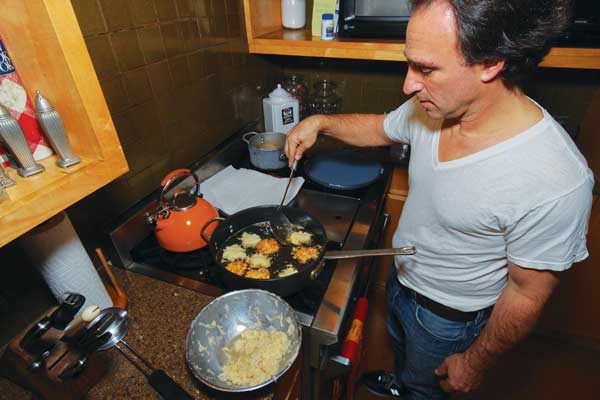
BY TEQUILA MINSKY | Hanukkah came early this year, the first night of candle lighting was the evening of Dec. 8. The holiday is celebrated with candles, playing dreidel, presents, and most important, eating latkes representing the miracle of the oil. Get out the potatoes.
In preparation for the holiday, my friend Barrett and I made a batch of potato pancakes. (I supplied the potatoes and onions, he, the oil, eggs, baking powder, salt, and flour.)
When he couldn’t find the right blade for the Cuisinart, he brought out the old hand graters – no problem. What’s a little muscle power?
That’s where the conflict began. He uses the larger grate, almost shredding the potatoes; I use the smaller grate.
It seems that in the tradition I grew up with, we used the finer grate on the box grater. Entrenched in my own family tradition, I never realized how prevalent is the choice for the style of a shredded potato latke. Admittedly, a perfunctory search on the Internet revealed a lot of recipes for the shredded variety.
Barrett and I split the recipe, making them both ways. The shredded variety came out great. In my – the more dense – method, I forgot to press the pancakes while they were frying, so they were a bit puffy and round. The following evening, I made another batch, also adding more onion, that came out better.
Of course, sour cream and applesauce were our complements.
It seems that in addition to these two competing potato pancake styles, latkes now are taking on new identities with all sorts of variations. One savory recipe calls for herbs and cumin, one adds a jalapeno pepper, another mixes in zucchini, one is made with cauliflower while another variation uses sweet potatoes.
In any case, I did find a nearby Lower East Side purveyor, so, if I don’t want to make my own, I can buy the authentic traditional kind, locally. Russ and Daughters makes a very credible, edible latke.
As for a recipe, here is my sister’s recipe, based on my grandmother’s:
Grandma Sadie’s Potato Latkes (Adapted from Sandy Weiswasser)
Makes about 36 2-inch latkes (10 to 12 servings)
Here are Grandma Sadie’s secrets: Use only russet baking potatoes — they’re drier and yield a better texture. Grate the onion first, then add grated potatoes. The onion will help prevent the potatoes from turning gray. Press out as much of the water from the grated potato mixture as possible; it’s the excess moisture that makes the latkes soggy. Also, use a skillet that conducts heat evenly for best frying results. Serve with sour cream and applesauce.
Corn or canola oil, enough to come about halfway up the skillet
1 very large onion, cut in half
6 large russet baking potatoes, peeled, cut into chunks and placed in cold water
2-3 beaten eggs
1/2 teaspoon baking powder
1 1/2 teaspoons salt, or to taste
About 2 tablespoons flour, or more as needed
1/4 teaspoon white pepper (optional)
Heat the oil over medium heat in a large, heavy skillet. Have ready a baking sheet/plate lined with paper towels.
In the food processor, pulse to coarsely grate half of the onion. Add half of the potato chunks to the onions and pulse to coarsely grate the mixture. Place mixture in a sieve and press repeatedly until as much water as possible has been removed. Transfer mixture to a large mixing bowl. Repeat with remaining onion and potato. Add to bowl. Add eggs, baking powder, salt, flour and white pepper, if desired, to potato mixture, mixing well; add slightly more flour if mixture does not stay together. When oil is hot enough (test by dropping a few strands of grated potato into oil; the oil should begin to bubble around them immediately), drop heaping tablespoonfuls of latke mixture into the oil. Fry for about 4 minutes, turning them over when bottoms are golden brown. Fry for 3 to 4 minutes on the second side.
Transfer to the paper towel-lined sheet as you work. Adjust heat and remove browned bits from the oil as needed. Serve hot.


































